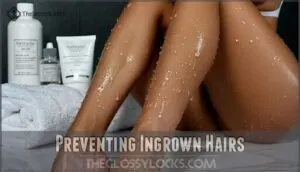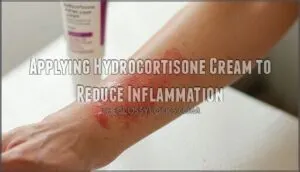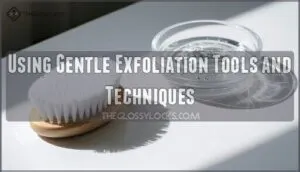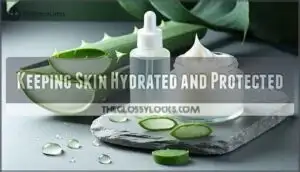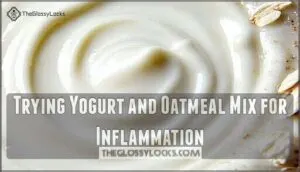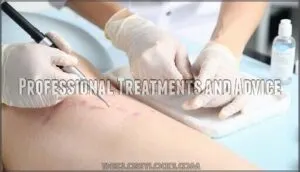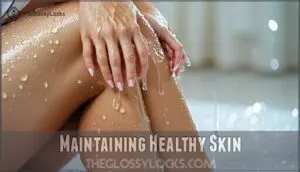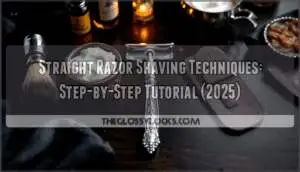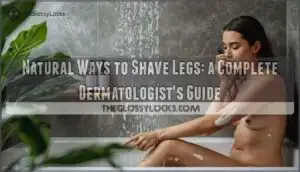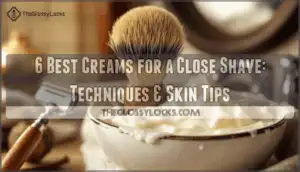This site is supported by our readers. We may earn a commission, at no cost to you, if you purchase through links.
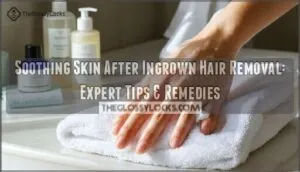 Soothing skin after ingrown hair removal starts with keeping things simple.
Soothing skin after ingrown hair removal starts with keeping things simple.
Skip tight clothes and let your skin breathe—think pajamas, not skinny jeans.
Gently cleanse the area, then apply aloe vera gel or a fragrance-free moisturizer to reduce redness.
A cold compress works wonders for swelling.
If the spot’s extra angry, a dab of over-the-counter hydrocortisone cream can calm things down.
Remember, hands off—no picking or scratching.
These steps help your skin bounce back without drama.
With a little patience, you’ll be back to smooth sailing.
Curious about natural remedies and expert tricks?
There’s more wisdom just around the corner.
Table Of Contents
- Key Takeaways
- Post Hair Removal Care
- Preventing Ingrown Hairs
- Soothing Skin After Removal
- Natural Remedies for Ingrown Hairs
- Professional Treatments and Advice
- Maintaining Healthy Skin
- Frequently Asked Questions (FAQs)
- How do you get rid of ingrown hair?
- Are there professional treatments for ingrown hairs?
- How does hair removal affect ingrown hairs?
- Is it safe to remove ingrown hairs at home?
- Do ingrown hair serums work?
- What should I put on my skin after hair removal?
- What to put on skin after removing ingrown hair?
- How to calm skin after hair removal?
- How to heal broken skin from ingrown hair?
- What to do when skin grows over ingrown hair?
- Conclusion
Key Takeaways
- Keep the area clean, moisturized, and avoid tight clothing to let your skin breathe and heal faster.
- Use fragrance-free aloe vera gel, cold compresses, or hydrocortisone cream to calm redness and reduce inflammation.
- Don’t pick or scratch—hands off prevents infection and helps your skin recover faster.
- Protect treated skin from sun exposure with broad-spectrum sunscreen and stick to gentle exfoliation to prevent future ingrown hairs.
Post Hair Removal Care
After removing an ingrown hair, your skin needs immediate care to prevent infection and reduce irritation.
Treat your skin like royalty after ingrown hair removal—gentle care now means less irritation and faster healing.
Proper aftercare helps your skin heal faster while minimizing the risk of new ingrown hairs forming in the treated area, which is crucial for preventing infection.
Avoiding Irritation and Infection
Why risk turning your fresh-start skin into a battlefield? Clean the affected area with mild antibacterial soap and warm water to prevent infection.
Avoid touching or scratching the treated area to prevent bacterial contamination. Keep the area clean and dry to minimize bacterial growth, and monitor for signs of infection like increased redness, swelling, or warmth requiring medical attention.
Proper hair removal techniques are essential to prevent such complications.
It is crucial to follow these steps carefully to ensure the skin remains healthy and free of infection, and to practice good hygiene.
Applying Moisturizer and Aloe Vera
After hair removal, your skin craves gentle care to prevent irritation and promote healing.
Apply moisturizer immediately to lock in hydration and create a protective barrier against environmental stressors.
Essential aftercare steps:
- Choose fragrance-free moisturizers with aloe vera gel or chamomile to minimize sensitivity reactions
- Apply gentle products containing ceramides or hyaluronic acid for deep skin soothing benefits
- Use natural soothing skin tips like coconut oil for moisturizing and ingrown hair relief
Protecting Skin From Sun Exposure
After moisturizing treated areas, sun protection becomes your skin’s best defense against post-removal complications.
Fresh hair removal sites are highly vulnerable to UV damage, making broad-spectrum sunscreen use non-negotiable for the first 24-48 hours.
Sunscreen Use Guidelines for Treated Skin
| Protection Level | Recommended Action |
|---|---|
| SPF 30+ | Apply every 2 hours outdoors |
| Physical sunscreen | Use zinc oxide or titanium dioxide |
| Broad-spectrum | Protects against UVA and UVB rays |
| Water-resistant | Choose for active days or swimming |
| Fragrance-free |
Prevents additional skin irritation.
Your aftercare products should include UV protection as a cornerstone of your skin care routine.
Skin shields like clothing and shade provide additional barriers when sunscreen alone isn’t enough for thorough skin protection.
Using Cold Compresses to Reduce Inflammation
Immediately after hair removal, apply Cold Therapy using ice wrapped in cloth for 5-10 minutes.
This Inflammation Reduction technique constricts blood vessels, minimizing swelling and redness.
Cold compresses provide instant Skin Soothing relief, helping your skin recover faster.
These simple Compress Techniques offer effective skin irritation relief without harsh chemicals or expensive treatments.
Preventing Ingrown Hairs
The best defense against ingrown hairs starts with proper prevention techniques that keep your follicles clear and healthy.
You’ll want to focus on gentle exfoliation methods and smart shaving practices that work with your skin’s natural healing process rather than against it, utilizing gentle techniques to maintain skin health.
Exfoliating With Chemical Exfoliants
Chemical exfoliants reveal your skin’s potential by dissolving dead cells that trap hairs beneath the surface.
Salicylic acid benefits include deep follicle penetration, while gentle chemical exfoliants with proper acid concentration maintain healthy skin pH.
These gentle products outperform harsh scrubs, making skin exfoliation methods more effective for preventing future ingrowns.
Regular use of chemical exfoliants can lead to improved skin health benefits, enhancing the overall appearance of the skin with gentle chemical exfoliants and resulting in better skin health and skin exfoliation.
Avoiding Harsh Scrubs and Rough Tools
Your skin deserves better than aggressive scrubbing after hair removal.
Skip rough loofahs and harsh exfoliating tools that can damage sensitive areas. Instead, choose soft tools like washcloths or gentle mitts for skin protection.
Use fragrance-free, mild cleansers designed for ingrown hair care. These gentle skin products reduce skin irritation while providing effective soothing methods without compromising your skin’s natural barrier.
Regular exfoliation routines are essential for preventing ingrown hairs and maintaining healthy skin with effective soothing methods.
Shaving in The Direction of Hair Growth
Beyond gentle tools, proper shave techniques prevent follicle damage and reduce irritation.
Always shave in hair’s natural growth patterns to minimize trauma to hair follicles. This razor selection strategy decreases skin tension and supports effective ingrown hair care.
- Follow your hair’s natural compass – Growth patterns vary by body area, so map yours first
- Choose multi-blade razors wisely – More blades can increase skin irritation and follicle damage
- Maintain ideal skin tension – Stretch skin gently to create smooth shaving surface
- Apply consistent pressure – Light, even strokes prevent razor burn and promote skin soothing techniques
Soothing Skin After Removal
After removing an ingrown hair, your skin needs immediate care to prevent inflammation and infection. The right post-removal routine reduces irritation and promotes faster healing.
Applying Hydrocortisone Cream to Reduce Inflammation
When prevention falls short, hydrocortisone cream becomes your skin’s ally.
Apply a thin layer of 1% hydrocortisone cream to inflamed areas up to four times daily for effective inflammation reduction.
This topical treatment delivers targeted skin relief, minimizing redness treatment concerns while providing antiinflammatory solutions.
The cream benefits include rapid skin soothing within 24-48 hours, making hydrocortisone effects particularly valuable after ingrown hair removal procedures.
For ideal results, consider combining hydrocortisone with a natural remedy approach to reduce inflammation and promote skin healing.
Using Gentle Exfoliation Tools and Techniques
Once irritation subsides, gentle exfoliation becomes your skin’s best friend for preventing future ingrown hairs.
Use soft brushes or washcloths with circular motions, avoiding harsh scrubs that can damage sensitive skin.
Chemical peels with glycolic acid offer effective skin buffing without physical irritation.
Start exfoliating 48 hours post-removal, limiting sessions to 2-3 times weekly for ideal ingrown hair treatment and skin soothing results.
For effective exfoliation, consider using gentle exfoliating tools to promote healthy skin and achieve skin soothing results.
Keeping Skin Hydrated and Protected
Two essential steps protect your newly treated skin: apply fragrance-free moisturizers with hyaluronic acid immediately after removal, then shield areas from sun exposure for 24 hours.
Gentle cleansing with aloe vera-based products maintains proper skin hydration while soothing skin creams containing ceramides create a protective barrier against environmental irritants.
Avoiding Picking at Ingrown Hairs
Resisting the urge to squeeze or pick at ingrown hairs protects your hair follicle from serious skin infection.
Your fingernails harbor bacteria that can turn minor irritation into painful complications requiring medical intervention.
Instead, practice gentle cleansing with warm compresses and use skin soothing oils like tea tree or jojoba.
These ingrown hair remedies promote natural healing while skin calming methods reduce inflammation safely.
Natural Remedies for Ingrown Hairs
When ingrown hairs leave your skin irritated and inflamed, natural remedies can provide gentle relief without harsh chemicals.
These time-tested treatments use ingredients you likely have at home to reduce swelling, fight bacteria, and calm angry skin.
Using Cucumber Slices and Cold-Pressed Coconut Oil
Cucumber slices and cold-pressed coconut oil work together to calm irritated skin after ingrown hair removal. These natural remedies provide gentle relief without harsh chemicals.
Here’s how to use these skin soothing remedies:
- Place chilled cucumber slices on affected areas for 10-15 minutes to reduce swelling
- Apply thin layer of cold-pressed coconut oil to moisturize and prevent infection
- Combine both treatments for maximum cucumber benefits and oil therapy effects
- Repeat daily until skin calming methods show improvement
The steps outlined above offer a simple, effective way to achieve gentle relief from ingrown hair removal irritation using natural ingredients.
Applying Diluted Tea Tree Oil and Witch Hazel
Moving beyond cooling treatments, natural antiseptics offer powerful skin-soothing benefits.
Tea tree oil‘s antibacterial properties reduce inflammation when properly diluted—mix 1-2 drops with 12 drops carrier oil for safe application.
Witch hazel’s natural astringent qualities calm irritated skin and tighten pores.
Apply witch hazel first, followed by diluted tea tree oil treatment for effective ingrown hair prevention and skin irritation reduction.
Understanding ingrown hair causes is essential for effective prevention and treatment of ingrown hairs.
Trying Yogurt and Oatmeal Mix for Inflammation
Simply combine plain Greek yogurt with finely ground oatmeal to create this DIY inflammation relief powerhouse.
The yogurt benefits include lactic acid that gently exfoliates, while oatmeal properties provide beta-glucan compounds that calm irritated skin.
Apply this mix application directly to affected areas for fifteen minutes.
This remedy effectiveness stems from yogurt’s probiotics reducing skin inflammation naturally, making it perfect for soothing post-removal sensitivity.
Using Green Tea Compresses for Antioxidants
Green tea compresses harness potent antioxidants like EGCG to combat inflammation and accelerate healing around ingrown hair sites.
You’ll steep green tea bags for five minutes, cool them, then apply for ten-minute sessions twice daily.
The natural antiinflammatory properties reduce skin redness while promoting cellular repair.
Consider chamomile or white tea alternatives if you experience skin sensitivity reactions.
Professional Treatments and Advice
When home remedies aren’t cutting it, it’s time to call in the professionals who know how to tackle stubborn ingrown hairs without turning your skin into a battlefield.
Dermatologists have access to prescription treatments and advanced techniques that can resolve persistent issues and prevent future flare-ups.
Consulting a Dermatologist for Persistent Issues
When persistent ingrown hair issues resist your best home remedies, it’s time to seek professional guidance.
Sometimes stubborn ingrown hairs need a dermatologist’s expertise to finally get your skin back on track.
A dermatologist can diagnose underlying conditions contributing to treatment resistance and provide targeted solutions for severe inflammation and scarring concerns. Topical retinoids can also be prescribed to prevent hair follicle plugging.
- Severe Inflammation that doesn’t respond to over-the-counter treatments requires prescription-strength interventions
- Persistent Infections with redness, warmth, and swelling need immediate medical evaluation to prevent complications
- Diagnostic Uncertainty about recurring ingrown hair patterns benefits from professional skin dermatologist consultation and customized prevention strategies
Using Professional-Grade Treatments for Severe Ingrown Hairs
When home remedies just aren’t cutting it, a dermatologist can offer professional-grade ingrown hair solutions.
You might need prescription retinoids to speed up cell turnover, surgical extraction for stubborn cases, or laser therapy to reduce future ingrown hairs.
Sometimes, steroid injections or advanced exfoliation help calm skin inflammation. Hydrocortisone cream may also be prescribed to soothe irritated skin quickly.
Following Expert Recommendations for Post-Removal Care
If professional-grade treatments aren’t enough, expert product choices and dermatologist consultations can make all the difference.
Specialized aftercare, like using skin soothing oils or fragrance-free creams, speeds up the skin healing process and helps with skin redness reduction.
Stick to a maintenance schedule for lasting ingrown hair prevention, and consider medical interventions as the gold standard for stubborn cases, ensuring reliable ingrown hair solutions.
Maintaining Healthy Skin
You can keep your skin healthy after ingrown hair removal by using gentle moisturizers, regular exfoliation, and sun protection.
These simple steps help maintain your skin’s barrier and reduce future irritation.
Establishing a Regular Exfoliation Schedule
After professional treatments, you’ll want to keep your skin on the right track with a steady exfoliation schedule. Think of it as routine maintenance for long-term benefits and ingrown hair prevention.
Here’s how to get it right:
- Exfoliation Frequency: 2–3 times weekly.
- Tool Selection: Soft mitts or sponges.
- Product Ingredients: AHA exfoliants.
- Sensitive Skin: Adjust as needed.
This routine is essential for maintaining healthy skin and preventing issues such as ingrown hairs, making routine maintenance a crucial part of your skincare regimen.
Using Gentle Moisturizers and Lotions With Aloe and Chamomile
After hair removal, your skin’s begging for a little TLC. Reach for a gentle moisturizer loaded with aloe vera or chamomile—these ingredients calm inflammation and promote healing.
Hypoallergenic options suit sensitive skin best. Many look to aloe vera products for relief.
Here’s a quick look:
| Moisturizer Ingredient | Aloe Benefits |
|---|---|
| Aloe Vera | Soothes redness |
| Chamomile | Reduces irritation |
| Glycerin | Locks in moisture |
Protecting Skin From Sun Exposure and Irritation
Anyone who’s braved the sun post-ingrown hair knows the sting of regret.
Sunscreen application is your best shield, but don’t stop there—clothing protection, like hats and loose sleeves, keeps skin calm.
Avoid peak sun hours to dodge irritation.
Hydration importance can’t be overstated; drink up.
If you overdo it, soothing sunburns is key for effective hair removal aftercare.
Frequently Asked Questions (FAQs)
How do you get rid of ingrown hair?
Some say tweezing works, but science favors gentle exfoliation and warm compresses to coax the hair out.
Don’t dig or pick—let nature do the heavy lifting.
If redness or pain persists, consult your dermatologist pronto.
Are there professional treatments for ingrown hairs?
You can visit a dermatologist for treatments like laser therapy, chemical peels, or prescription creams.
If ingrown hairs keep popping up or get infected, don’t tough it out—medical help can save your skin’s day.
How does hair removal affect ingrown hairs?
Imagine a game of Whac-A-Mole—removing hair can sometimes push new ones to grow sideways, causing ingrown hairs.
You’ll lower risk by exfoliating, moisturizing, and shaving with the grain.
Gentle care helps keep your skin clear.
Is it safe to remove ingrown hairs at home?
You can remove ingrown hairs at home, but tread lightly—digging too deep risks infection or scarring.
Stick to clean tweezers, gentle pressure, and never force it.
When in doubt, let a dermatologist take the wheel.
Do ingrown hair serums work?
Ever wondered if those serums for ingrown hairs actually pull their weight?
They often help by exfoliating and calming inflammation with ingredients like salicylic acid or tea tree oil.
Results vary, but many find relief with consistent use.
What should I put on my skin after hair removal?
After hair removal, reach for a fragrance-free moisturizer with aloe vera or chamomile.
Cold compresses can calm redness.
Loose clothing is your best friend—think “no friction, no problem.”
Sunscreen protects sensitive skin, so don’t skip it, as it is a crucial part of protecting sensitive skin.
What to put on skin after removing ingrown hair?
Freshly freed from an ingrown hair, your skin’s like a traffic jam finally clearing—give it breathing room.
Dab on fragrance-free aloe vera or hydrocortisone cream, then let loose-fitting clothes and gentle moisturizer do the heavy lifting.
How to calm skin after hair removal?
Skip hot showers and tight clothes—let your skin breathe.
Dab on aloe vera or a fragrance-free moisturizer for instant relief.
A cold compress works wonders.
If redness sticks around, don’t hesitate to check with your dermatologist.
How to heal broken skin from ingrown hair?
Imagine you accidentally picked at an ingrown hair and now your skin’s looking rough.
Clean the area gently, apply a fragrance-free moisturizer with aloe, and cover with a bandage.
If redness or pus shows up, see your doctor.
What to do when skin grows over ingrown hair?
When skin closes over an ingrown hair, don’t dig or pick.
Instead, apply a warm compress to soften the area, gently exfoliate after 48 hours.
See a dermatologist if redness, pain, or infection develops.
Conclusion
Think of your skin as a garden—after ingrown hair removal, it needs gentle care to thrive.
By focusing on soothing skin after ingrown hair removal, you reduce irritation and lower infection risk.
Stick to evidence-based steps: moisturize, use aloe, and avoid picking.
Simple routines, like cold compresses or gentle exfoliation, help restore balance.
If problems persist, consult a dermatologist. With patience and consistent care, your skin can recover smoothly, leaving you comfortable and confident.
- https://theellaeffect.com/waxing-aftercare-how-to-care-for-your-skin-post-waxing/
- https://lotustotalcare.com/how-to-maintain-smooth-skin-after-laser-hair-removal/
- https://laviemd.us/how-to-care-for-your-skin-after-laser-hair-removal-15-expert-tips/
- https://waxwax.com/how-do-you-treat-ingrown-hair/?srsltid=AfmBOoo0Go1u0I2WbcpqODEAbBHDqpUle7XKblcJSz2o0wnH_m1QyhVK
- https://smoochaesthetics.com/laser-hair-removal-what-you-need-to-know/

